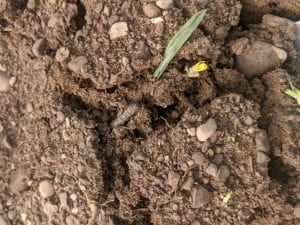Contents
Black cutworm (Agrotis ipsilon)
Black cutworm moth captures have been very high in western and eastern NY this year. Larvae are present in fields now. Unless you have a triple stacked hybrid or insecticide treated seed you should be out and scout for this insect pest. The economic threshold is 5% of corn plants cut in a field. For more information:
https://cals.cornell.edu/field-crops/corn/insects-corn/cutworms
Interactive Pheromone Trapping Network Map
Cereal Leaf Beetle
Cereal leaf beetle has been found in small grains fields in Western NY. A few fields have been over threshold and have been treated. Make sure to use scouting and thresholds for making decisions for insecticide applications.
For more information on Cereal Leaf Beetle:
https://cals.cornell.edu/field-crops/small-grains/insects-small-grains
Wireworm-Early Season Corn Seed Pest
We are seeing a lot more wireworm in seed treatment plots then last year. In some cases, they seem to be at pretty high levels and have had some damage to untreated corn seed. Wireworm is the larval form of a click beetle. Most of the time we find them in a first-year field after sod. They can drill through seed and the base of the corn plant. In some cases, they can kill or weaken a plant.
Stripe Rust on Winter Wheat
Dr. Gary Bergstrom-Field Crops Plant Pathology- Cornell University
We have identified stripe rust on winter wheat in three fields at the flowering stage in Yates County, NY. Samples have been collected and sent to the USDA-ARS Stripe Rust Lab in Pullman, WA for fungal race determination. These occurrences are unexpected because the closest wheat stripe rust sightings for 2023, both at very low levels, have been in Kentucky and Virginia. Rather than initial spore inoculum arriving on air currents this spring, I believe the local Yates Co. outbreaks are the result of fall infections that survived the winter on green wheat leaves. This could have occurred in other sheltered wheat fields in other areas of New York as well, so be on the lookout for stripe rust near you. Please inform me (gcb3@cornell.edu) and send images if you think you have observed stripe rust. More information and photos of this disease are available at:
One of the affected fields in Yates is beyond effective treatment as the flag leaves are already infected. Should you observe stripe rust in the lower leaf canopy, but not yet on flag leaves, fungicidal treatment could protect the flag leaves and prevent yield loss. The fungicidal products recommended for suppression of Fusarium head blight and vomitoxin, when applied within 7 days of the initiation of flowering, will also protect flag leaves against stripe rust infection. These products are Caramba, Miravis Ace, Prosaro, Prosaro Plus, and Sphaerex. Fungicide applications made more than a week after flowering are not likely to result in a positive return on investment; also check for days to harvest restrictions on specific products.
Potato Leafhopper in Alfalfa
Potato Leafhopper is present in NYS. As the weather starts to get warmer the pest will increase in population. Make sure to scout your alfalfa every week to 10 days. Remember that newly planted alfalfa is more susceptible to damage by this pest. For more information, please refer to the following fact sheet on the pest. https://cals.cornell.edu/field-crops/forages/insects-forage-crops/potato-leafhopper#:~:text=The%20potato%20leafhopper%2C%20Empoasca%20fabae,and%20stunting%20of%20regrowth%20alfalfa.





